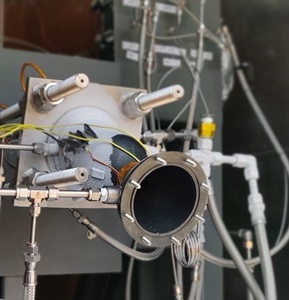Agnikul Cosmos, a Chennai-based space startup, has become the world’s first entity to successfully test a fully 3D printed rocket engine. Agnikul has successfully fired the higher stage semi-cryogenic rocket engine, called Agnilet.

The engine can power a rocket carrying 100 kg payload into lower earth orbit (LEO), ie, up to 700 km.
“This entire engine is just one piece of hardware from start to finish and has zero assembled parts,” said co-founder and CEO Srinath Ravichandran.
The entire rocket engine is 3D printed from top to bottom. What comes out of the 3D printer can directly be used in the rocket. There is no complexity in assembly or fabrication, and the turnaround time is less than four days, he explained.
Agnikul Cosmos developed its single piece, fully 3D printed rocket engine, Agnilet, and its cryogenic pump.
Ravichandran said the semi-cryogenic rocket engine will be operating on liquid propellants. The rocket engine will be burning kerosene in liquid oxygen.
Agnikul has partnered with the Department of Space (DoS) under IN-SPACe entity to develop launch vehicles.
The co-founder explained that a rocket engine is a device that is capable of burning gases and releasing them at extremely high velocities. These gases released from a rocket’s nozzle will exert an equal and opposite force on the rocket, pushing it to move in the other direction.
Launched in 2017 by Srinath Ravichandran and Moin SPM, Agnikul Cosmos is involved in building India’s private small satellite launch vehicle. Srinath said this rocket engine will be used in the second stage of Agnikul’s launch vehicle Agniban, which has been designed to carry up to 100 kg of payload to low earth orbits of up to 700 km with a plug-and-play engine configuration.
“We have been testing engines since 2018 at smaller scales. So, subscale versions of this engine have been tested. However, a full-scale test will be done shortly,” he adds.
Last month, the IIT-Madras incubated Agnikul became the first startup to enter into a non-disclosure agreement with the Department of Space (DoS) under the newly established Indian National Space Promotion and Authorisation Centre (IN-SPACe) entity.
While Agnikul is the first company to be successful in such an endeavour, there are others that are fast catching up and realise the value of 3D printed engines versus conventional assembly.
Rocket engines normally have 100s of different parts that have to be built individually. This includes things like injectors which inject fuel into the engine, cooling channels that ensure the engine doesn’t overheat and the igniter which actually kindles propellants to push the rocket off the ground
Another space startup, Hyderabad-based Skyroot Aerospace founded by former Indian Space Research Organisation (Isro) scientists Pawan Kumar Chandana and Naga Bharath Daka, had, in September last year, unveiled their fully 3D printed cryogenic rocket engine, dubbed Dhawan-I.
Dhawan-I will be used to power the Vikram-II rocket, which Skyroot is also building from scratch.
The startup entered an NDA with the DoS earlier this month. The company will be able to use Isro’s test and launch facilities to test their Vikram-I rocket and eventually Dhawan-I as well.
The global space industry is expected to generate $1.1 trillion or more by 2040, according to Morgan Stanley — more than triple its current value of $350 billion. And, new space engine technologies like 3D printed rocket engines are expected to play a big role in this explosion of value.
Agnikul’s success is commendable considering the fact that even international players like Elon Musk’s SpaceX, the National Aeronautics and Space Administration (NASA), Ursa Major and Jeff Bezos’ Blue Origin are only 3D printing components for rocket engines. This means that putting together these engines and making sure they work is still a fairly complicated task.
The only entity that is close to producing a fully 3D printed rocket engine is US-based startup Firehawk Aerospace, but they have only raised the $2 million needed to start on their project.







.webp)















